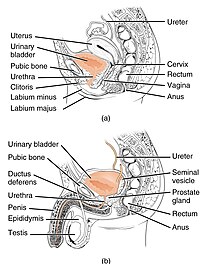
Photo from wikipedia
Abstract Objective The purpose of this survey was to assess the prevalence of genital and urinary tract symptoms among Japanese women with declining estrogen levels. Methods A health-related questionnaire survey… Click to show full abstract
Abstract Objective The purpose of this survey was to assess the prevalence of genital and urinary tract symptoms among Japanese women with declining estrogen levels. Methods A health-related questionnaire survey was conducted among women in their 40s or older to inquire about their genital, intercourse-related, and urinary symptoms and concern over their symptoms. Results Of the consecutive 10,000 respondents recruited, 4488 (44.9%) reported having symptoms: 3546 (79.0%) expressed concern over their symptoms. Furthermore, 2173 women (21.7%) had incontinence, 1999 (20.0%) had urinary frequency, 1648 (16.5%) had itching, and 1560 (15.6%) reported odor; these were followed by looseness, dryness, and burning. Of the 2518 (25.2%) sexually active women, 518 (20.6%) reported having dyspareunia and more reported having urinary symptoms than genital symptoms. Of the symptomatic respondents, 33.1% had genital symptoms alone, 28.4% had urinary symptoms alone, and 38.4% had both. More sexually active women had genital symptoms, while more sexually inactive women had urinary symptoms. Conclusions Genital and urinary symptoms were shown to be common and coexist in a considerable proportion of the respondents, highlighting the pathology of genitourinary syndrome of menopause. Again, dyspareunia and lower urinary tract symptoms were shown to be quite common among postmenopausal women.
Journal Title: Climacteric
Year Published: 2020
Link to full text (if available)
Share on Social Media: Sign Up to like & get
recommendations!